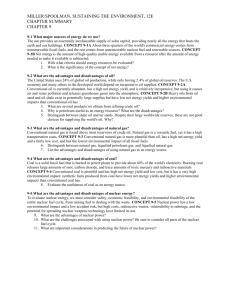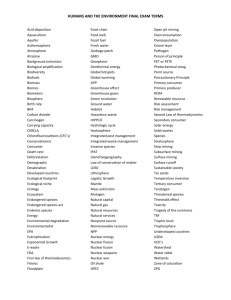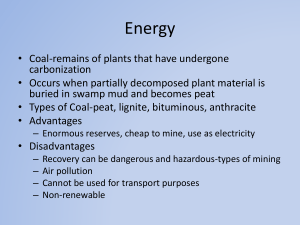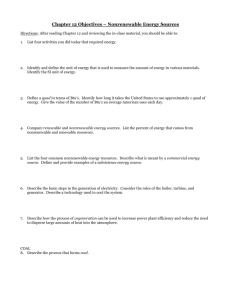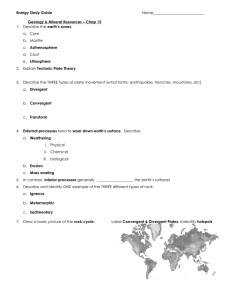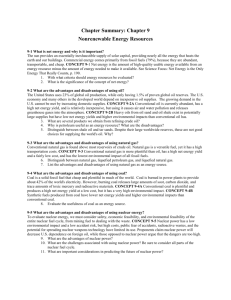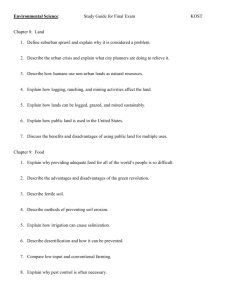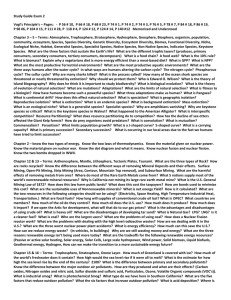Unit 9 Study Guide Q's
advertisement
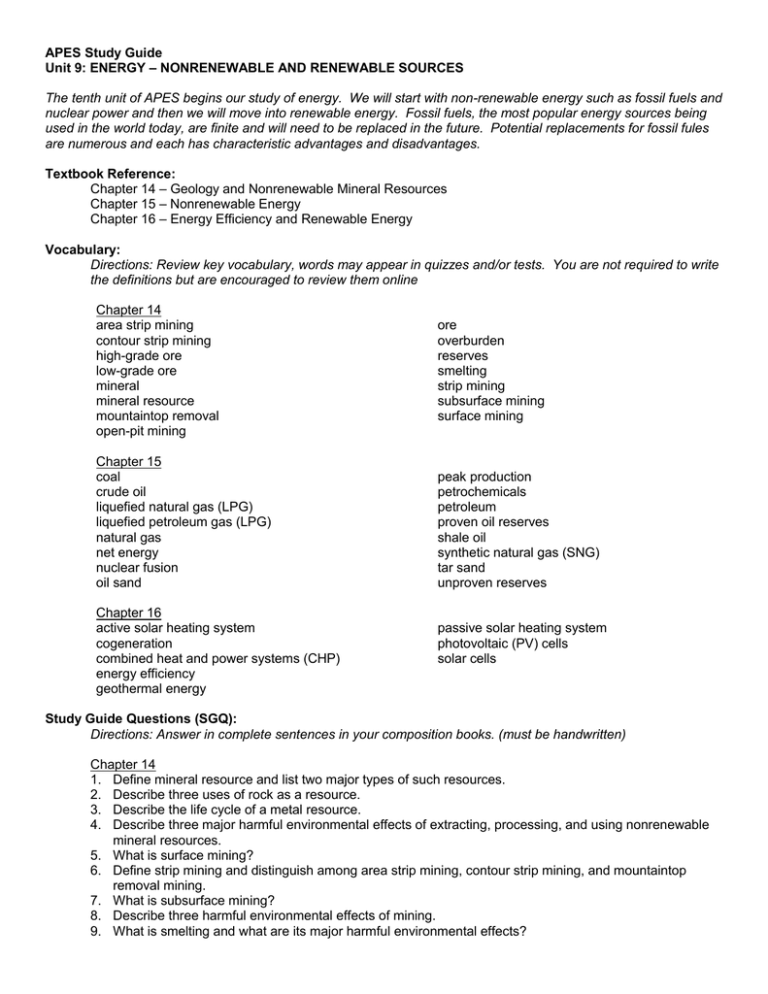
APES Study Guide Unit 9: ENERGY – NONRENEWABLE AND RENEWABLE SOURCES The tenth unit of APES begins our study of energy. We will start with non-renewable energy such as fossil fuels and nuclear power and then we will move into renewable energy. Fossil fuels, the most popular energy sources being used in the world today, are finite and will need to be replaced in the future. Potential replacements for fossil fules are numerous and each has characteristic advantages and disadvantages. Textbook Reference: Chapter 14 – Geology and Nonrenewable Mineral Resources Chapter 15 – Nonrenewable Energy Chapter 16 – Energy Efficiency and Renewable Energy Vocabulary: Directions: Review key vocabulary, words may appear in quizzes and/or tests. You are not required to write the definitions but are encouraged to review them online Chapter 14 area strip mining contour strip mining high-grade ore low-grade ore mineral mineral resource mountaintop removal open-pit mining Chapter 15 coal crude oil liquefied natural gas (LPG) liquefied petroleum gas (LPG) natural gas net energy nuclear fusion oil sand Chapter 16 active solar heating system cogeneration combined heat and power systems (CHP) energy efficiency geothermal energy ore overburden reserves smelting strip mining subsurface mining surface mining peak production petrochemicals petroleum proven oil reserves shale oil synthetic natural gas (SNG) tar sand unproven reserves passive solar heating system photovoltaic (PV) cells solar cells Study Guide Questions (SGQ): Directions: Answer in complete sentences in your composition books. (must be handwritten) Chapter 14 1. Define mineral resource and list two major types of such resources. 2. Describe three uses of rock as a resource. 3. Describe the life cycle of a metal resource. 4. Describe three major harmful environmental effects of extracting, processing, and using nonrenewable mineral resources. 5. What is surface mining? 6. Define strip mining and distinguish among area strip mining, contour strip mining, and mountaintop removal mining. 7. What is subsurface mining? 8. Describe three harmful environmental effects of mining. 9. What is smelting and what are its major harmful environmental effects? 10. Describe the conventional view of the relationship between the supply of a mineral resource and its market price. 11. What are five effects of a mineral becoming scarce? 12. Discuss the pros and cons of the U. S. General Mining Law of 1872. 13. Describe the opportunities and limitations of finding substitutes for scarce mineral resources. 14. Describe the benefits of recycling and reusing valuable metals. List five ways to use nonrenewable mineral resources more sustainably. Chapter 15 1. Describe our history of energy use over the last three hundred years. 2. What is net energy and why is it important for evaluating energy resources? 3. Explain why the nuclear fuel cycle has a low net energy yield and thus must be subsidized to compete in the open marketplace. 4. What is crude oil (petroleum) and how is it extracted from the earth and refined? 5. What percentages of the commercial energy use in the world and in the United States are provided by crude oil? 6. What is the peak production for an oil well and for the world? 7. What is a petrochemical and why are such chemicals important? 8. Discuss the question of how long global and U. S. supplies of conventional crude oil might last. 9. What are the major advantages and disadvantages of using conventional oil as an energy resource? 10. What is tar sand, or oil sand, and how is it extracted and converted to heavy oil? What are some environmental problems related to the use of this resource? 11. What is shale oil and how is it produced? 12. What are the major advantages and disadvantages of using heavy oils produced from tar sand and shale oil as energy resources? 13. Define natural gas, liquefied petroleum gas (LPG), and liquefied natural gas (LNG)? 14. What three countries have most of the world’s natural gas reserves? 15. What are the major advantages and disadvantages of using conventional natural gas as an energy resource? 16. What are three sources of unconventional natural gas and what major problems are related to the use of these resources? 17. What is coal and how is it formed? 18. How does a coal-burning power plant work? 19. What three countries have the largest proven reserves of coal? Describe the use of coal in China. 20. Describe the problem of coal ash waste. 21. Explain why there is no such thing as clean coal. 22. What are the major advantages and disadvantages of using coal as an energy resource? 23. What is synthetic natural gas (SNG)? What are the major advantages and disadvantages of using liquid and gaseous synfuels produced from coal? 24. How does a nuclear fission reactor work and what are its major safety features? 25. Describe the nuclear fuel cycle. 26. Describe some of the consequences of the Chernobyl nuclear power plant accident. 27. What are the major advantages and disadvantages of relying on the nuclear fuel cycle as a way to produce electricity? 28. Compare the advantages and disadvantages of using the nuclear fuel cycle and coal to produce electricity. 29. How do nuclear power plant operators store highly radioactive spent fuel rods? 30. Why are spent fuel rods vulnerable to terrorist acts? 31. What is the connection between commercial nuclear power plants and the spread of nuclear weapons? 32. How can we deal with the highly radioactive wastes produced by the nuclear fuel cycle? 33. What can we do with worn out nuclear power plants? 34. Discuss whether using nuclear power can reduce U.S. dependence on imported oil. 35. What role is nuclear power likely to play in slowing projected global climate disruption caused in part by emissions of carbon dioxide? What role might new-generation nuclear power plants play? 36. What is nuclear fusion and what is its potential as an energy resource? 37. Describe what happened to conventional nuclear power and its possible role in the future. Chapter 16 1. Explain why we can think of energy efficiency as an energy resource. 2. What percentage of the energy used in the United States is unnecessarily wasted? 3. List four widely used energy-wasting technologies. 4. What are the major advantages of reducing energy waste? 5. Describe three ways to save energy and money in (a) industry, (b) transportation, (c) new buildings and (d) existing buildings. 6. What is cogeneration (combined heat and power or CHP)? 7. How could we encourage electric utility companies to reduce their energy waste? 8. What is a smart grid and why is it important? 9. Describe the trends in fuel efficiency in the United States since the 1970s. 10. Explain why the price of gasoline is much higher than what consumers pay at the pump. 11. Distinguish among hybrid, plug-in hybrid, and fuel- cell motor vehicles. 12. Describe the possible connection between wind farms and plug-in hybrid cars. 13. Summarize the search for better batteries and describe two promising new developments. 14. What is a living roof? 15. What is the importance of a white or light-colored roof? 16. What is a superinsulated house? 17. Compare the efficiency of incandescent, compact fluorescent, and LED light bulbs. 18. Explain how using compact fluorescent light bulbs can reduce overall air pollution from toxic mercury. 19. What are green buildings and why are they important? 20. List six ways you can save energy where you live. 21. Give three reasons why we waste so much energy. 22. List five advantages of relying more on a variety of renewable energy sources and describe two factors holding back such a transition. 23. Distinguish between a passive solar heating system and an active solar heating system and discuss the major advantages and disadvantages of such systems for heating buildings. 24. Discuss the major advantages and disadvantages of concentrating solar energy to generate hightemperature heat and electricity. 25. What is a solar cell (photovoltaic or PV cell) and what are the major advantages and disadvantages of using such devices to produce electricity? 26. What are the major advantages and disadvantages of using hydropower? 27. What is the potential for using tides and waves to produce electricity? 28. What is a wind turbine? What is a wind farm? 29. What are the major advantages and disadvantages of using wind to produce electricity? 30. Explain why the United States is the “Saudi Arabia of wind energy.” 31. What are the major advantages and disadvantages of burning wood to provide heat and electricity? 32. What are biofuels and what are the major advantages and disadvantages of using biodiesel and ethanol to power motor vehicles? 33. Evaluate the use of corn, sugarcane, and cellulose plants to produce ethanol. 34. Describe the potential for using algae and bacteria to produce gasoline and diesel fuel. 35. What is geothermal energy and what are three sources of such energy? 36. What are the major advantages and disadvantages of using geothermal energy as a source of heat and to produce electricity? 37. What are the major advantages and disadvantages of using hydrogen as a fuel and to produce electricity and to power motor vehicles? 38. List three general conclusions of energy experts about possible future energy paths for the world. 39. List five major strategies for making the transition to a more sustainable energy future. 40. Describe three roles that governments play in determining which energy resources we use.
